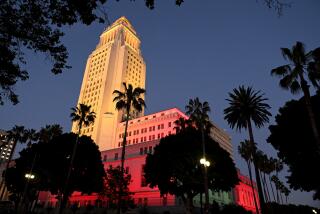After a Long Separation, a Union Is Made on ‘Main Street’
- Share via
The Los Angeles City Council chambers resemble a medieval castle or cathedral, a grand hall of a room with towering ceilings, marble floors and columns, and churchlike wooden pews.
Awe-inspiring, and perhaps even intimidating, if not for the proletarian pair of scoreboards above the council president’s chair.
Scoreboards, like the ones they have at baseball stadiums.
They light up every time the council takes a vote. Not only a practical accessory amid the grandeur but a reminder that this is, after all, a game for some of the participants.
The business at hand Friday was the anticipated adoption of the Ventura Boulevard Specific Plan, a complicated set of regulations aimed at controlling development along the Valley’s “Main Street.” City planners, lawyers and civic-minded residents tired of their friendly little markets turning to mini-malls had waited five years for this moment, and the faithful filled the pews to witness local history.
There was Fred Kramer, a semi-retired wholesale carpet dealer from Sherman Oaks who served on the committee that hammered out the plan’s original draft. His hair was black when the process began, Kramer playfully told the council three weeks ago; now it is nearly white.
“Fourteen of the 21 people on the committee were pro-development, and anything that went through had to have two-thirds of the majority,” said Kramer, a dignified man of 70 in a camel-hair sports coat.
“The disappointing thing to me is to see the developers squeezing and pressing even today, when they had two-thirds of the majority to begin with on that committee,” Kramer said. Still, he was not cynical.
“I know large organizations and how they work,” he continued. “The democratic process is great but can be speeded up.”
The slow pace of democracy took the council three hours to finally adopt the plan, after disposing of an agenda of 40 other issues, such as whether the city should add 21 members to an ethics committee.
In the meantime, the real action was in the aisles to the left and right of the council members’ U-shaped platform, where an endless cycle of huddles went on between council members and council aides, lawyers and clients, caught up in the drama of building and development, of quality of life versus profit margins and ever more buildings for ever more people.
There was Ben Reznik, the land-use attorney, whispering something into Councilman Hal Bernson’s ear. Then Reznik conferred with his client, Jona Goldrich, a prominent developer whose rumpled clothes and heavy Polish accent contrast with his reputation for power and wealth. Reznick and Goldrich both carried portable phones and were accompanied by an entourage that included a public relations woman.
There was Cindy Miscikowski, Councilman Marvin Braude’s chief aide, whispering into his ear, listening closely, and then taking some sort of proposal to Reznik, Goldrich and Goldrich’s associate Sherman Gardner.
A last-minute disagreement between Goldrich and Braude’s office had threatened to unravel a compromise they struck on a big Encino project. By afternoon’s end, it was all worked out.
There was Rob Glushon, president of the Encino Property Owners Assn., walking from Reznik to Miscikowski to a group of residents whose houses abut the Goldrich project.
If they didn’t agree to shave five feet off a setback between the project and their homes they might have to put up with movie theaters, Glushon told them during a tense, 11th-hour negotiating session in Braude’s office.
There was Leonard Shapiro, a retired health-and-beauty aid salesman from Granada Hills and a regular at City Council meetings. Shapiro, apparently unconcerned by the Specific Plan, addressed the council during the public comment portion of the meeting, pounding the podium with passion over the ethics committee.
“I was the second-largest distributor of health and beauty aids in the city,” Shapiro explained later. “Then I got a heart attack and decided I didn’t want to be the richest man in the cemetery so I came down here to relax.”
Back to Reznik, who could have used roller skates to shuttle from one side of the pews to the other, from his associate, attorney Fred Gaines, on a Sherman Oaks project to Goldrich on the Encino project. Miscikowski copped sips of Diet Coke when she could.
At long last the council turned to the plan, and with it Braude’s efforts to please both developer Goldrich and the neighbors of his project. The councilman, a slight man with hair as gray as Kramer’s, stood at his seat and in a solemn voice, like a clergyman performing a marriage ceremony, asked Reznik:
“Are you prepared to support the terms of this covenant?”
“Yes, we are,” Reznik replied.
“And are you prepared to sign it?” Braude asked.
“Yes, we are.”
“And do you support the plan here today?”
“We do.”
No one kissed, but it was clear at that moment that the plan would be adopted. When it actually was, just minutes later, a beaming Miscikowski turned to city planners Dick Platkin and Deuk Perrin and shook their hands, starting a domino effect of handshaking among the huddlers.
“We’ll be having a celebration for the citizens advisory committee and you’ll come, too,” Miscikowski told the officials.
Otto von Bismarck, whose conniving united Germany in the 19th Century, might have felt right at home. It was Otto who observed that those who value sausages or laws might feel better if they did not see them being made.
More to Read
Sign up for Essential California
The most important California stories and recommendations in your inbox every morning.
You may occasionally receive promotional content from the Los Angeles Times.













